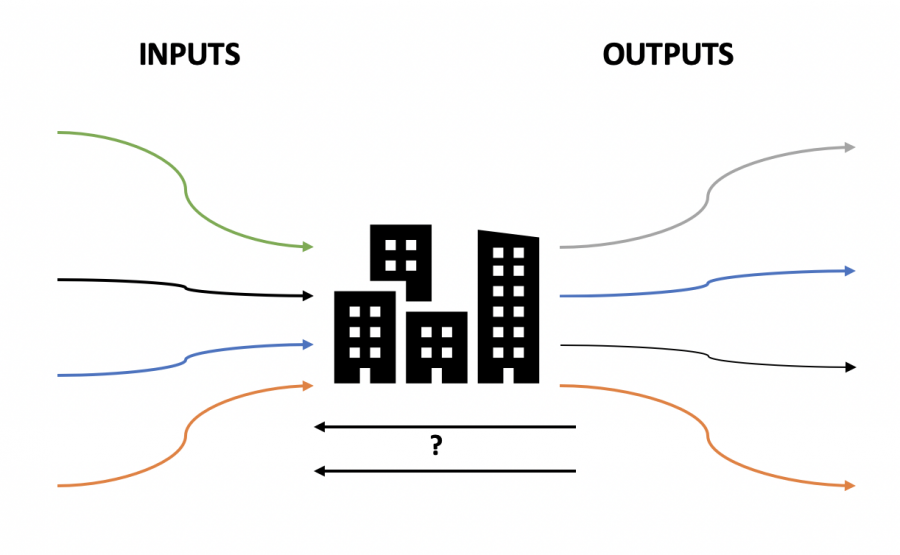
A downloadable version of this lesson is available here:
Many learners will already be familiar with the Gaia Hypothesis, which explores both the metaphorical and literal body of planet Earth as a superorganism: a bio-geo-sphere engaged in homeostasis, with climate change seen as a form of imbalance, or sickness. Urban metabolism is a metaphor that helps us imagine how to model a city’s metabolism like it is an organism, using resource flows into cities, the cycling of energy and material goods, and the disposal of waste. Additionally, a “smart city” is one that pursues a high level of technological monitoring to generate data on energy use, traffic flows, water supplies, and waste streams. However, promoters of smart cities are only beginning to assess how technology might facilitate greater equality among city residents and help cities achieve gains in resource efficiency and reductions in waste. The challenge is not to maximize inputs of energy, food, water, and material goods to cities (this quantitative measure may be seen as a 20th-century goal)—but instead, to use technology and metabolism theory to optimize the entire urban population’s access to sustainable services and healthy environments (a qualitative goal). As 21st-century human migration to cities increases alongside the pressures of climate change, the techno-socio-environmental challenge of how to develop and manage cities sustainably is at a critical juncture. This lesson will use the concepts of urban metabolism and smart cities to have learners explore initiatives that bring tomorrow’s cities closer to human equality and ecological balance with their surroundings.
- Learn and apply crucial concepts in urban sustainability to specific resource streams.
- Integrate sustainable resource use and climate adaptation and mitigation with equality and environmental justice.
- Envision and begin to design a mid-21st-century city that has proactively integrated smart technologies, metabolism theory, and inclusive ethics.
- Discern between quantitative and qualitative measures of well-being to reduce material-resource use while enhancing the habitat and well-being of all city residents.
In groups of three to four, take 4 minutes to sketch a flow diagram of inputs and outputs of a city. These may be material and/or cultural flows. Be creative about integrating both “goods” and “wastes” into your diagram. Then, for 1–2 minutes, assess how your outputs could be recovered into the input category to create a closed loop of resource flow.

Green Infrastructure: Urban Metabolism and Smart Cities (One 75-minute class)
-
As preparation for class, have learners read and take notes on the articles by Ulgiati & Zucaro (2019) and Obringer & Nateghi (2021), paying special attention to the highlighted portions. In the lesson, learners will review p. 25-34 of Circular Charlotte: Towards A Zero Waste & Inclusive City.
DocumentUlgiati & Zucaro 2019 – Highlighted.pdf (124.22 KB)DocumentDocumentCircular Charlotte Report.pdf (12.4 MB) -
(10 min.) Review important lesson concepts using these lesson PPT slides.
Document -
(5 min.) Divide the class into groups of three to four learners and assign each group a focus area (below). Depending on the gathering size, there may be multiple groups that focus on the same area. Note that some of these foci will overlap with others in critical ways. For example, the “waste” group is also concerned with water, food, energy, and material goods, as these all end up in a conventional city’s waste stream. The “food” group may have ideas that positively influence habitat, energy, and waste. The focus areas are as follows:
- Water
- Food
- Energy
- Habitat and Inclusive Well-Being
- Material Goods
- Transportation
- Waste (solid, liquid, airborne).
-
(10 min.) Groups should begin by quickly reviewing p. 25-34 of Circular Charlotte: Towards A Zero Waste & Inclusive City. With their focal topic in mind, have each group read this idealistic narrative and take notes on how these visions of a sustainable and equitable future may apply to their topic.
-
(20 min.) Now, have each group envision and detail two topic-specific initiatives that integrate concepts of circularity, smart city technologies, climate change adaptation and/or mitigation, and environmental justice. They may not be able to integrate all of these inputs at once. That is okay, so long as they start to develop ideas for how their new initiatives could evolve to integrate other needs. Each group should come up with multiple ideas for each of their initiatives and these should include a focus on the environmental benefits, as well as the social goals of inclusion and equality. For example, how would a zero waste stream be achieved using smart city technology; and next, how would that initiative improve the quality of life for disadvantaged residents? Consider quality of habitat, good jobs, community development, and shared governance. Note: ideally, any plans for smart city technology should be designed with these social goals as integral to its success, not as retrofits.
-
(20 min.) Invite groups to share in brief (3 min.) their two initiatives with the full assembly. Each idea should develop the environmental benefits, as well as the social goals of inclusion and equality. The instructor or an appointed notetaker should compile the ideas in a single document as groups present. The notetaker should organize ideas across two columns: environmental sustainability and equality.
-
(5 min.) To finish this session, have learners review the list of initiatives with environmental and social benefits. Ask learners to observe which ideas seem synergistic and mutually enabling across topics. Take a show of hands to vote on which two initiatives seem most integrative, actionable, and exciting to them. Highlight these favorite ideas.
-
Optional Extension: For homework, ask learners to develop a 500-word essay (it could be modeled on the Circular Charlotte example) that pitches one initiative to a fictional city mayor.
-
What is Urban Metabolism?
This short video provides an engaging overview of the idea of urban metabolism by distinguishing linear from circular metabolism and re-conceptualizing old waste streams as resources to be integrated back into the system to serve the city’s needs.
UN Environment Programme. (2017, August 31). What is Urban Metabolism? [Video]. YouTube. https://www.youtube.com/watch?v=uu-a1hFEV7Q&t=4s
-
Toward Sustainable Urban Metabolisms. From System Understanding to System Transformation
This review article surveys 221 publications on urban metabolism to explore the transformational potential of designing sustainability solutions for socio-ecological dynamics. Researchers identify eight clusters of urban metabolism research highlighting the diversity of research along disciplinary and methodological dimensions. It concludes with suggestions for collaboration between urban metabolism and sustainability research.
John, B., Luederitz, C., Lang, D.J., & von Wehrden, H. (2019). Toward Sustainable Urban Metabolisms. From System Understanding to System Transformation. Ecological Economics, 157, 402-414. https://doi.org/10.1016/j.ecolecon.2018.12.007
-
Smart cities: Digital solutions for a more livable future
This report by the consulting firm McKinsey and Company takes an optimistic and technology-first approach to analyzing and implementing monitoring and big data in future cities. It profiles the unrealized potential in 50 global cities and integrates quality of life goals with economic and environmental needs. An executive summary is available.
Woetzel, J., Remes, J., Boland, B. et al. (2018). Smart cities: Digital solutions for a more livable future. McKinsey Global Institute. https://www.mckinsey.com/capabilities/operations/our-insights/smart-cities-digital-solutions-for-a-more-livable-future
-
Urban Metabolism
This chapter is useful as it provides an introduction to urban metabolism, covers its history, and describes three different methods for calculating urban metabolism. It ends with an interesting case study.
Derrible, S., Cheah, L., Arora, M. et al. (2021). Urban Metabolism. In W. Shi, M. Goodchild, M. Batty et al. (Eds.), Urban Informatics (pp. 85-114). Springer Open Book Series. https://doi.org/10.1007/978-981-15-8983-6_7
-
Metabolism of Cities
This is a useful resource to which the instructor can direct more advanced learners. The open access website and platform stores and shares urban metabolism data, provides links to tools for collecting metabolism data, and more generally serves as a central repository for a wide variety of information pertaining to urban metabolism in cities around the world. It includes lessons and also a hub for the urban metabolism research community.
Metabolism of Cities (n.d.). https://metabolismofcities.org/